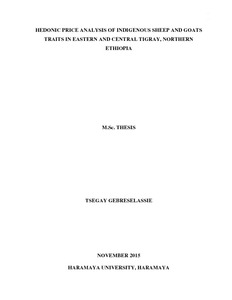Resource information
Small-ruminant production contributes significantly to the national and household economy in many countries. Small-ruminants are a key component of the livelihood systems in rural Ethiopia which substantially contribute to income, food, skin and wool, manure, serve as part of the crop failure risk-coping portfolio of enterprises, for asset wealth security as a form of saving money and social and cultural functions. This study analyzes hedonic price analysis of indigenous sheep and goats traits in two districts (Atsbi-Wemberta and Adwa) of eastern and central Tigray, northern Ethiopia. In this study two sets of respondents were used: sheep and goats buyers and producer farm households. In order to provide context for the hedonic price analysis, a total of 100 farm households who are closer to the study markets were selected using multi-stage sampling technique. For the hedonic analysis, a total of 250 sheep and goat transactions were surveyed. The descriptive results from the sample of farm households showed that small-ruminant producers mainly kept sheep and goats for income sources, meat and manure. Male sheep (rams) were selected for breeding purpose based on body conformation, performance history and coat color. The farm households practiced fattening of sheep and goats for target market season’s mainly for Ethiopian New Year festival, Christmas and Easter when prices are better. Farmers preferred to purchase sheep and goats during crop harvesting and planting. Prevalence of diseases and parasites, feed and grazing land shortages and drought were major production constraints of sheep and goats while seasonality of markets and low market prices were major marketing constraints of sheep and goats. To determine hedonic factors (traits) that are dominantly influencing implicit prices of indigenous sheep and goats, a hedonic pricing model was fitted to a sample of 125 sheep and 125 goats. Both OLS and Heteroscedasticity-Consistent regression analysis were employed for comparison. Results of the empirical hedonic model consistently indicate that phenotypic traits of traded indigenous sheep and goats are important determinants of prices than buyer’ and sellers’ attributes or other factors. Based on Heteroscedasticity-Consistent-3 standard errors, the most influential sheep traits in determining the prices paid in the studied markets were age, age square, medium and big body size, average body condition, fat-tailed and thin-tailed. On the other hand, the most influential determinants of goat traits were sex, age, medium and big body size and average and poor body condition. Thus result implies the importance of trait preferences in determining indigenous sheep and goats traits related to buying and selling of sheep and goats in the studied primary markets. Factors such as district market place/location, purpose of purchase (for butchering and restaurants), and seller types (farmer-trader and middlemen (assembler/trader) were important determinants of prices of indigenous goats. Purpose of purchase (for restaurant) was also important determinant of prices of indigenous sheep. Proximity of district market place indicates that smallholder goat producers could benefit if they carefully choose market places. Hence, sheep and goats breeders should properly consider the preferences expressed through the prices paid for animal traits (age, sex, body size, body condition and tail type) in such markets. Therefore, breeding strategies and programs with marketing element are fundamental for sustainable sheep and goats improvement and small-ruminant producers and buyers could benefit from the intervention.



